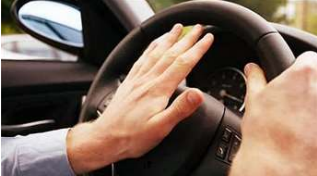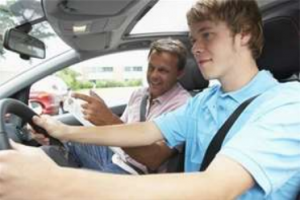What is amaxophobia?
Amaxophobia is the phobia or fear of driving a vehicle; it can be caused by, for example
insecurity, the involvement of loved ones in accidents or any kind of
related painful memory. It often manifests itself in real panic attacks and several individuals suffering from amaxophobia complain of anxiety and agitation on the days or hours they have to drive a vehicle.

It can occur in varying degrees, to the extent that this phobia affects life
social status of the individual; for example, avoiding going out if there are no transportation alternatives. This
can affect you professionally, due to the problems caused by not being able to
move. Clinically, it is categorized as a specific phobia or anxiety disorder caused by an irrational fear of exposure to specific objects or situations.
Factors that cause fear of driving
1-Novice drivers or drivers with loss of skills due to
age:
- Inadequate teaching.
- Anxiety disorders.
- Self-esteem deficit.
- Denigratory and disqualifying criticism.
2-Panic attack while driving:
- Stress and anxiety.
- Fear-driving association.
3- People with post-traumatic stress:
- They’ve been in traffic accidents or someone close to them.
- They have witnessed traffic accidents.
Below is a very interesting report about amaxophobia in Spain.
Amaxophobia acquisition process
How does it come about? Why does it happen? According to experts, it usually starts with an acute anxiety attack (sometimes a panic attack) while driving. The person who has this negative experience experiences a dangerous lack of control that can be accompanied by a series of catastrophic thoughts, and a strong fear of the possibility that the crisis will be repeated or that a traffic accident will occur.
It may also gradually appear, or begin to fear driving in adverse conditions such as rain or snow. You can even start to experience fear of driving at night. In addition, this type of situation leads to negative thoughts and feelings towards oneself, such as: «everyone can drive but me», «I’m worse than everyone else», «I’m not good for anything», etc. Such thoughts diminish self-esteem and reinforce the fear of driving and anxiety. When the first crisis has been experienced, it is also possible that when driving in the same area or on a similar road again, insecurity, great restlessness and anxiety may arise, which becomes increasingly difficult to bear.
At this point, people suffering from amyxophobia usually end up restricting the roads they drive on or even stop driving indefinitely to avoid the fear it causes.
A driver’s ability to be frightened is the result of personal factors and
family and social environment. The personal factors that most influence the intensity of the fear of driving are:
- The level of anxiety and the development of related psychological disorders
- The degree of self-efficiency and self-esteem.
- The age of onset of driving.
- The need to drive.
If, in addition, in the first experiences as a driver these events occur, it is
more likely to suffer from amaxophobia:
- Inadequate learning that prevents solving daily traffic situations.
- Over-demanding, because it aims to achieve expert behaviour without the
sufficient experience. Attitude that entails accepting situations for which one
is prepared, consequently feelings of inadequacy are experienced. - Insecurity in oneself, which transforms our perception, easy situations
are lived with difficulties, thus increasing the feeling of incompetence. - Traffic accidents, which depending on their seriousness, can have consequences
psychics on the person, to «force» him to leave the traffic.

We can cite two main reasons why we may have amaxophobia:
- The urge to emulate expert drivers ends up causing a
feeling of failure and improper handling of the vehicle, in people with little
experience and low self-esteem. - The «scolding», criticism, frights, etc., end up turning driving into a stressful experience. This association (between driving and stress) leads to
sitting behind the wheel produces the state of anxiety before even getting behind the
traffic. Some people say that the concern appears just by thinking about the
possibility of having to drive.

A person who has amaxophobia tends to confirm his or her expectation so that events in which he or she does not intervene are interpreted as a consequence of his or her own
performance. For example, anxious people, afraid to drive, often think that any «beep» heard is meant for them.
Every conflict situation, every error by others, events that you do not understand will tend to
to see them as dangerous. You will experience the behavior of other drivers as
aggression to his person and will carry out evasive manoeuvres, generally unjustified, which due to their insecurity end up provoking risky situations.
The fear of driving often extends to riding in vehicles driven by other people. Because we unwittingly project our insecurity onto other drivers, inferring that they take risks because one would not dare to. Especially when the driving of the other is considered aggressive or very fast.
Common situations that produce driving phobia
- Circulation on bridges: visualize falls
- Circulation in tunnels: they think they’re locked in
- Circulation in fast lanes: they think they’re going to hit you
- Very tight curves: fear of the car overturning
- Roads with a separation wall: I’m going to hit the wall
- Parking: Perception of parking nuisance
- Great descents in mountain pass
- Heavy traffic: large vehicles
- Climatology
Tunnels
A person with a driving phobia tends to see the roadway narrow and has
the feeling that the tunnel will never end. Also, it’s common for me to lose
speed obstructing circulation.
In such cases, the following statement should be made: «In tunnels, the
lanes and they have an end.»
Another technique that works very well is to count the time it takes to cross the
tunnel focusing on traffic and the roadway.

Downhill
Downhill slopes are one of the most frightening situations for people with
amaxophobia, since they have a double sense:
– That the slope is increasing its angle of inclination.
– That the speed of the vehicle increases indiscriminately.
This translates into the following thoughts:
I’m falling!
The car is going alone!
I won’t be able to stop!
I’ll lose control of the vehicle!
I have to stop!
In these cases you have to avoid braking too hard and focus on the lane.
One technique that helps a lot in these cases is to go as a passenger and write down the
The following data is for the slope:
– Degree of slope on a scale of 1 to 5
– Speed in km/h
– Length of the slope.
– Time.
Afterwards, you must make the same journey as the driver and the passenger
Write down the same data so that you can assess the differences and know how to react.

Dealing with the fear of driving
Maybe after getting your license and going on your first solo trip, or after having a scare on the road, or after being involved in a traffic accident, or even for no apparent reason, you may notice at some point that you find it difficult to get behind the wheel, that you are afraid, that you are overwhelmed and that you get stuck. If this is the case with you, you suffer from a disorder called amaxophobia, which is more common than is commonly believed in our country.
The main reason why this fear or phobia is not overcome is avoidance. Faced with the fear of something (in this case driving), the most immediate response is to avoid the situation.
In addition, the fact of avoiding the situation, makes the person feel relieved to get away from the negative stimuli that generate anxiety, which causes the person to
reinforce and perpetuate this behavior.
For this reason, therapies used to overcome the fear of driving, seek the
The opposite effect, that the person is exposed to their fear, and has to deal with it.
In time, the person suffering from amyxophobia will realize that the very negative and catastrophic thoughts he or she has about driving are not for
so much.
The following video explains how to overcome the fear of driving, facing
to the problem:
In the following video, we show Sonia’s testimony and how she has managed to overcome her fear of driving by attending classes with a teacher who is an expert on the subject.
Types of amaxophobia that exist
Different types of amaxophobia according to the way they appear. Amaxophobia is a more common problem than we think in our society today. If we look at the time of onset of the disorder, those affected could be divided into three groups; broadly speaking, these are
1. NEW DRIVERS: It is very common for drivers with less than two years of experience to experience stress when facing traffic alone. Some even end up giving up driving.
2. EXPERIENCED DRIVERS: These are people who, after a few years of experience, begin to suffer from anxiety at the wheel, mainly on motorways or highways, without having a similar history. This may be due to personal or work stress.
3. DRIVERS WHO HAVE HAD A TRAUMATIC EXPERIENCE: here we can be talking about both those drivers who have suffered an accident on their own skin and those who have experienced the consequences of the accident of a family member or relative. In this type of driver, encountering an accident-like situation triggers anxiety in a very intense way.
It is not easy to know exactly how many people could live with this phobia, because there are not many studies on the subject. Fundación MAPFRE carried out one in 2005, with 1,500 respondents, which explained that «a third of drivers suffer at some point, to a greater or lesser extent, from fear of getting behind the wheel». This report, which states that fear is born for most of «the way other road users drive», includes in that percentage 18% of motorists who «feel a paralyzing fear».
• (AMAXOPHOBIA) PRIMARY: It occurs in adolescence, when driving is usually learned. Without any traumatic background the person begins to fear getting into the vehicle.
- (AMAXOPHOBIA) SECONDARY: Appears in individuals who have had traffic accidents. Although it also occurs in those who have witnessed an accident, or in those who have been heard of an explicit narrative of this type of event.
- (AMAXOPHOBIA) CONCURRENT: It is the one that is part of the symptoms of another disease. It is very common in patients suffering from panic disorders.
- (AMAXOPHOBIA) IN OBSESSIONAL-COMPULSIVE PATIENTS: The obsession that one has that one is going to crash has as answer the compulsion of not driving.
- (AMAXOPHOBIA) SITUATIONAL: It occurs only when the patient must drive in specific situations, such as in the rain, at night, on slopes and with passengers such as children or elderly people.
- (AMAXOPHOBIA) DELIRING: It is the least frequent. The subject thinks that the car can take on a life of its own or that they want to do some damage and they put a bomb in it.
Most common symptoms suffered
- Anticipatory anxiety, days and hours before thinking about driving
- Tremors
- Palpitations
- Upset stomach
- Sweating
- Tension headache
- Tachycardia
- Dizziness
- Sweating
- Muscle tension and exhaustion
How we fight the fear of driving at Autoescuela Guía
In our driving school we have three fundamental pillars to provide an effective treatment to overcome the fear of driving
- Good Information: We know your problem and we give you a solution. This phobia is shared by many, many people. Your problem has a solution.
- Adequate training: Guarantees and provides security and confidence.
- A strong dose of understanding and patience: reinforcement of your self-esteem.
Important points when dealing with our students
- Never just confront a person with fear, not all at once, it should be done gradually
- Transmit confidence to the student
- Making a successive approach to the problem
- Planning the student’s training, bringing him/her closer to it little by little
- Most amaxophobia is situational (rain, night, slopes, highways, passengers, children, elderly, etc)
- If it’s just one specific phobia, it’s easier to overcome
- Another method we use is to walk the student to the site (intersection, narrow street, etc)
- Work the breath, the first thing to be altered is the breath
- If we can modify our respiratory system, then deep breathing is the best
- To get a balance in the breathing and the mind, to make him think about something else
- Doing abdominal breathing
- Relaxation techniques is another self-control tool, there are many, any is valid, can last between 12 and 15 minutes approximately
- Looking ahead, the look is very important when driving
- No rigid thoughts when driving as traffic and conditions are always changing
- Find the focus of the problem
We must do our part to overcome the fear
- Being determined to overcome it
- Don’t be disappointed if the results are slow to appear, you must be patient
- Setting clear and achievable goals How far do I want to go?
- When do we start? Set a day to start, don’t leave it until tomorrow
- Use positive reinforcement. It is very important for the teacher to reinforce positive actions, not to lower his or her self-esteem. Normally women need more self-esteem reinforcements
Steps we follow for a complete treatment
We make a preliminary diagnosis: we gather as much information as possible about the problem, medical reports, survey, interviews.
We involve the person in the process:
- Importance of your attitude
- Set clear goals, achievable objectives
- We explain how the learning will take place, we are a group (student-teacher)
- We explain how we will help you, what the role of the teacher is
- We create a climate of mutual support and acceptance
- We make a calendar of classes and explain what each class will be about
Systematic desensitization: analyzing feared situations or stimuli before facing them.
Cognitive and exposure treatment:
- With dual control vehicle, then own vehicle, step by step
- Overcoming situations, reducing anxiety
- Removing bad habits, the first thing is to remove bad habits (clutch, speed, intersections, overcoming ramps, incorporation, etc) to gain safety
Final objective: autonomous driving.
Stages of the practical classes
- First, a double-drive car
- Second with your own vehicle
- Follow-up on the back: seeing the teacher in the mirror
- the professor is in the back with his car
- the teacher is in the front with his car
In all classes we create a pleasant and comfortable atmosphere for the student. We work on self-esteem, positive thoughts and avoid negative ones. We transmit security and confidence to the student, always keeping him/her calm. We use progressive relaxation techniques and diaphragmatic breathing (breathing is super important because this way you don’t think about anything else, we focus on breathing, inhaling through the nose and exhaling through the mouth). We encourage the student with achievable and motivational goals, classes adapted to their interests.
Conclusions
The goal of this guide is to facilitate understanding of the anxiety disorder we call amaxophobia and to provide strategies for overcoming it. By following our advice, you can gradually reduce your fear.
- On the positive side, 90-95% of those who suffer from amaxophobia manage to overcome it.
- Between 30 and 40 years of age, the proportion of phobias is higher.
- One in five drivers has anxiety and distress at the wheel.
- 14 million Spaniards suffer from amaxophobia.
- 38% of women suffer from it.
- In general terms it affects more women between 30 and 40 years old, they get more comfortable in the car and say «Here, you drive it».
- Men are also afraid and do not recognize it.
Profiles that tend to suffer from the disease
- women are more sensitive to the disease because of hormonal differences
- women are more susceptible, more vulnerable, they think they haven’t done well
- is more common in women in their 40s than in men
- in men related to loss of abilities (60 years)
The most common causes of this disease are:
- Panic attacks, many people have been driving for a long time and suddenly start experiencing panic symptoms for no reason.
- The poor preparation of the drivers, this leads to that with the passage of time people stop driving because they feel indecisive with what they do.
Amaxophobia can be overcome with the right treatment. Most people who try to overcome it choose to go back to driving school, ask family members for help or see a psychologist to treat their phobia, but to solve the problem it must be addressed on several fronts and in several stages.
Amaxophobia Questionnaire
Do you find it harder to drive every day or can’t you even think about being able to use the vehicle normally?
When you need the car, do you get overwhelmed and can’t stop thinking about it?
Do you often end up changing your plans that require you to use the car so as not to have a bad time?
Do you calm down once you are behind the wheel?
Do you drive with the feeling that you are being harassed by the other drivers you meet?
Do you only get scared in some very specific circumstances, related to the weather, the night, etc?
Do you know other people who are also afraid in these situations?
Do you sometimes stop and manage to calm down, continuing to drive afterwards?
Do you drive very carefully, but do you manage to go at the speed of others?
Do you have the feeling that you are a hindrance to other drivers?
Do you make any excuse for not recognizing your fear of driving?
Do you think you can endanger the lives of others?
Are you more afraid of some driving situations, such as curves or motorways, but not all situations?
Would it be a major limitation for you not to overcome this fear?



